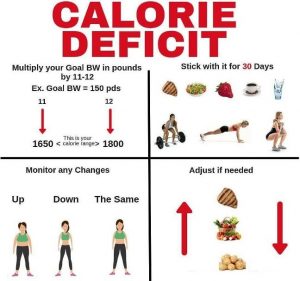A calorie deficit is an essential recipe in all weight loss programs. Basically, it means that you are burning (and/or excreting) more calories than you are eating. This results in a situation where your body is taking the excess calories from its fat store, resulting in a net loss of fat reserves, and, therefore, weight.
How Much Are You Taking in?
The first step in determining whether you are achieving a calorie deficit is to determine how much you are really eating. Calorie counting is the way this is normally done. It’s important to realize, though, that not all food calories are the same. When you look at the label for calories, the value is based on a calculation of the amount of carbohydrates, proteins, and fats contained in the food. However, recent research has shown that not all calories are created equal.
That’s because we can’t necessarily digest all the foods we eat in equal measure. Raw vegetables, for example, are hard for the body to break down, and more of the (already low) calories are passed through the body without entering our system. Cooking vegetables helps break them down, making more of the calories accessible to our bodies. Some nuts, especially almonds and pistachios, remain resistant to digestion, even after roasting.
Carbohydrates in simple sugars and cooked grains—especially refined grains like white bread—are more easily digestible and give us closer to their full content (and, if you calculate the low difficulty of eating, even more, net calories). Proteins and fats spend more time in our digestive tract than vegetables, meaning more of them might be digested as well.
It’s important to understand that a simple calorie count may not yield the exact results you want—you might need to change the proportion of your foods to get the results you desire.
How Much Are You Burning?
The other important side to the calorie deficit equation is how many calories you’re burning. This includes not only the amount you burn exercising, but also the amount you burn just metabolizing—breathing, making new skin cells, digesting, and all the other things your body does without you having to do a thing. This resting metabolic rate (RMR, or sometimes basic metabolic rate, BMR) is likely a pretty sizeable chunk of your total calorie consumption of the day.
The best way to determine this—and the only really accurate way to determine how many calories you burn while exercising is to be hooked up in a contained environment where your respiration can be measured precisely. However, you can get an estimate of your RMR using a formula called the Mifflin St. Jeor Equation. For men, this equation is:
RMR= 4.55*weight (lbs)+14*height (inches)-5*age (years) + 5
For women, subtract 161 at the end rather than adding 5. This gives a basic estimate of the number of calories (technically Calories or kilocalories—food calories, what gets reported on food labels) that you burn without exercising.
Add to this the amount you burn while exercising (but be careful, many exercise machines add in your RMR, so be careful not to double count), and you can get a good idea of the amount you burn on a daily basis. Make sure it’s less than what you’re taking in, and you’ll lose weight.
Of course, that’s often easier said than done. If you are looking for help in achieving weight loss in Denver, please contact MedFit Medical Weight Loss Clinic in the Stapleton area today for an appointment.

